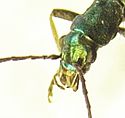Chrysanthia geniculata
| Chrysanthia geniculata | ||||||||||||
|---|---|---|---|---|---|---|---|---|---|---|---|---|

Chrysanthia geniculata slightly changed
|
||||||||||||
| Systematics | ||||||||||||
|
||||||||||||
| Scientific name | ||||||||||||
| Chrysanthia geniculata | ||||||||||||
| ( Schmidt , 1846) |
Chrysanthia geniculata is a beetle fromthe longhorn beetle family (Oedemeridae). The metallic green, blue or copper colored beetle is not uncommon, but because of its small size of five to eight millimeters in length, little attention is paid to it. In the standard work Freude-Harde-Lohse for the beetles of Central Europe it is still listed under the name Chrysanthia nigricornis . In the Fauna Europaea, Ch. Nigricornis is listed as a synonym for Ch. Geniculata .
Description of the beetle
As with all mock horned beetles, the front hip cavities are open at the back. The front hips are cone-shaped and touch. At the base they are only separated by a small triangular extension on the front chest. The same goes for the mid-hips and mid-chest (picture 1). The hind hips are separated. The front rails have two end pins. The hind tarsi are four-limbed, all others five-limbed (tarsi formula 5-5-4). In all tarsi the limb in front of the claw limb is widened like a lobe on both sides. Only the first link of the hind tarsi is tomentose below.
The pronotum is elongated, heart-shaped, rounded on the sides and unedged. It is significantly narrower than the elytra.
The head is stretched forward and not suddenly constricted behind the temples. The eyes are on the side of the head. They are highly arched and ovate when viewed from the side. The forehead is much wider between the eyes than between the antennae turns. The antennae are eleven-part, thread-shaped and arise far in front of the eyes (Fig. 2). The second antenna element is relatively long and only about half as long as the third. The jaw probe is four-part. The first link is very small, the end link of the jaw probe is ax-shaped (in picture 2 on closer inspection it can be seen on the right side, on the left concealed by the alignment. Also in picture 3 it is narrower in perspective).
The wing covers are bent down to the sides and only slightly narrowed backwards. The rounded shoulders clearly protrude beyond the base of the pronotum. Each wing cover has four slightly raised veins. Three are visible in the supervision. The fourth (lateral) arises from the shoulder bulge and runs parallel to the lateral edge of the elytra, widely separated from it. In Figure 3, the golden-green stripe at the wing end due to the exposure is limited by the third wing vein and the edge of the wing coverts. The wing covers gape slightly at the back and the seam is at most marginalized near the tip.
Chrysanthia geniculata differs from the very similar species Chrysanthia viridissima in the hairiness, the formation of the pronotum and the ribs on the elytra and the color. The hairiness of the elytra is shorter in Ch. Viridissima than in Ch. Geniculata and pointing backwards, in Ch. Geniculata directed obliquely outwards. Only in Ch. Geniculata are single, long, black, protruding bristle hairs between the adjacent hairs . The pronotum of Ch. Geniculata is shorter than that of Ch. Viridissima and its anterior margin is truncated, while in Ch. Viridissima it is slightly outlined in the center. In Ch. Geniculata , the pronotum has no central longitudinal line and is hardly indented on the sides , in Ch. Viridissima, on the other hand, its sides are more strongly and a central longitudinal line is indented. The elytra in Ch. Viridissima are lively dotted, so that the longitudinal ribs are also uneven, while in Ch. Geniculata the elytra are extinguished and the ribs protrude smoothly. The legs and antennae are dark in Ch. Viridissima , while in Ch. Geniculata the base of the antennae, thighs and splints are yellow. The front rails of both are yellow at the bottom.
Synonyms
- Chrysanthia nigricornis Westhoff, 1881
- Chrysanthia viridis W. Schmidt, 1846
Occurrence
The beetles are found in Europe , east to Siberia .
Way of life
The adults eat pollen , the larvae eat coniferous wood , in which they also develop.
literature
- Harde, Severa: Der Kosmos Käferführer, The Central European Beetles , Franckh-Kosmos Verlags-GmbH & Co, Stuttgart 2000, ISBN 3-440-06959-1
- Edmund Reitter : Fauna Germanica - The beetles of the German Empire. Volume 3 p. 407, KG Lutz, Stuttgart 1911
- Edmund Reitter: Fauna Germanica - The beetles of the German Empire. 5 volumes, Stuttgart KG Lutz 1908–1916, digital library volume 134, Directmedia Publishing GmbH, Berlin 2006, ISBN 3-89853-534-7
- Heinz joy , Karl Wilhelm Harde , Gustav Adolf Lohse (ed.): The beetles of Central Europe . tape 8 . Teredilia Heteromera Lamellicornia . Elsevier, Spektrum, Akademischer Verlag, Munich 1969, ISBN 3-8274-0682-X .
Web links
- www.insektenbox.de
- Image of Chrysanthia nigricornis
- Chrysanthia geniculata in Fauna Europaea
Individual evidence
- ↑ a b H. Freude, KW Harde, GA Lohse: Die Käfer Mitteleuropas, Vol. 8, page 86 . Spectrum Academic Publishing House in Elsevier 1966, ISBN 3-8274-0683-8
- ↑ a b c Chrysanthia geniculata (W. Schmidt 1846). Fauna Europaea, Version 1.3, April 19, 2007 , accessed on October 6, 2007 .


